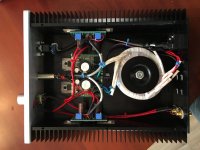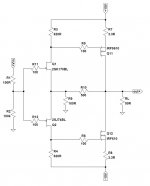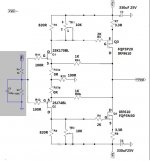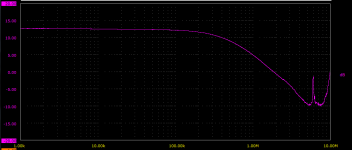Should I make the x-feed filter? Most of time people want to have high cyrosstslk rejection ratio?
http://www.diyaudio.com/forums/atta...f5-headamp-f5-ha-using-passive-cross-feed.pdf
http://www.diyaudio.com/forums/atta...f5-headamp-f5-ha-using-passive-cross-feed.pdf
I never try crossfeed filter before and want to try see if I like it or not.Should I make the x-feed filter? Most of time people want to have high cyrosstslk rejection ratio?
http://www.diyaudio.com/forums/atta...f5-headamp-f5-ha-using-passive-cross-feed.pdf
Sent from my HTC One E9PLUS dual sim using Tapatalk
When using crossfeed - is the signal normally buffered between the crossfeed and the volume pot? then straight into the F5-HA? Or what way is best to do it?
Using Soekris DAM as source, output impedance is approx 625R if i remember correctly. Maybe it would be good to buffer before the crossfeed also?
Using Soekris DAM as source, output impedance is approx 625R if i remember correctly. Maybe it would be good to buffer before the crossfeed also?
I just noticed the layout in post 1 does not match the schematic diagram. I built according to veroboard layout. It doesn't have 100k input resistor or 100R series resistor with 100R inputs. Gain is 10x or 20dB vs 5x (15dB). No 50R output load resistor.
Should I add these in? I am thinking of just changing feedback 1k resistor with 500R. Or leave alone and add input attenuator pot?
Should I add these in? I am thinking of just changing feedback 1k resistor with 500R. Or leave alone and add input attenuator pot?
When using crossfeed - is the signal normally buffered between the crossfeed and the volume pot? then straight into the F5-HA? Or what way is best to do it?
Using Soekris DAM as source, output impedance is approx 625R if i remember correctly. Maybe it would be good to buffer before the crossfeed also?
Are you using raw output or the buffered output from Soekris?
I think you can skip the buffer for the passive cross feed affording to Patrick.
http://www.diyaudio.com/forums/pass-labs/271926-f5-headamp-55.html#post4759695
I just realized the dual 1000R feedback in parallel is same as 500R.
http://www.diyaudio.com/forums/pass-labs/271926-f5-headamp-55.html#post4759695
I just realized the dual 1000R feedback in parallel is same as 500R.
It is really coming alive now. 😉
The RL 50R is just a dummy headphone load for Spice simulation.
You don't need to solder one into the circuit.
Patrick
The RL 50R is just a dummy headphone load for Spice simulation.
You don't need to solder one into the circuit.
Patrick
I wonder if two smaller 10VA toroidal transformers like how you did it in your nice boxed F5 HA had sonic benefits? The trafos are quite affordable when that small ($10ea).
Looking for ideas for a simple case to keep it all in. This is my first amp with no input cap. I think it's better not to have a cap - the detail and resolution is really nice.
I think the best thing about this amp is its simplicity. Fewer components for sound to go through and very simple to make. Definitely do not need a PCB as we can all see. The elegance of Mr Pass' original F5 basic topology is here and you don't need to have a house heater to enjoy pure class A sonics. My amp burns 3w ea - like a nightlight. Not too bad.
One more thing. This is my first Pass amp that has enough or even too much gain. 🙂
Looking for ideas for a simple case to keep it all in. This is my first amp with no input cap. I think it's better not to have a cap - the detail and resolution is really nice.
I think the best thing about this amp is its simplicity. Fewer components for sound to go through and very simple to make. Definitely do not need a PCB as we can all see. The elegance of Mr Pass' original F5 basic topology is here and you don't need to have a house heater to enjoy pure class A sonics. My amp burns 3w ea - like a nightlight. Not too bad.
One more thing. This is my first Pass amp that has enough or even too much gain. 🙂
Last edited:
2 channel, +/-15V rails, 150mA bias each is already 9VA.
You need to allow for further voltage loss across rectifiers and regulators.
So real consumption is ~ 15VA stereo.
To avoid ripple pulse current saturating the transformer, a Class A amp should allow for a factor of 2.5~3 in VA rating.
That means ~50VA in total, or 2x 25VA, as in the XEN Audio PCB.
The price and size difference between 10VA and 25VA is minimal, especially taking the complete build into account.
Patrick
You need to allow for further voltage loss across rectifiers and regulators.
So real consumption is ~ 15VA stereo.
To avoid ripple pulse current saturating the transformer, a Class A amp should allow for a factor of 2.5~3 in VA rating.
That means ~50VA in total, or 2x 25VA, as in the XEN Audio PCB.
The price and size difference between 10VA and 25VA is minimal, especially taking the complete build into account.
Patrick
Thanks for clarification. 10VA per amp monoblock was what I was thinking but it sounds like you say that is too low? For stereo with one trafo I planned on 50VA unit.

Thanks Patrick.
I will construct the cap multiplier section after the 317/337 and try that as well...I have a feeling the reg might be causing problems, I used what I had for the output and bypass caps, they are low esr. Usually not an issue but it might be with this amp.
I'll keep my eye out for a good scope. It is something I should have. Not ready to give up on this amp yet.
Also, for the caps in the cap multiplier section is it ok to increase the value from 330uf to say 2200uf? I have 4 2200uf nichicon fw left over from a previous project.
Cap multiplier (board under input jack) is done. I'll let you guys know over the next few days how it sounds. Initial listening tests are promising but I need to compare with my other amp which is at work now. Perhaps the lm317/337 was causing oscillation. That's my hope. Hopefully I will get a proper scope in the next few weeks to find out.
Attachments
A warning to those who are considering SMP as power supply.
We tested our HAGS open-loop Head Amp Gain Stage with a pair of SMPS.
Attached is the frequency response.
It tooks us quite some work before we found out that the hugh spike at 6MHz came from the SMPS.
For the high bandwidth F5-HA certainly not a good idea.
Patrick
We tested our HAGS open-loop Head Amp Gain Stage with a pair of SMPS.
Attached is the frequency response.
It tooks us quite some work before we found out that the hugh spike at 6MHz came from the SMPS.
For the high bandwidth F5-HA certainly not a good idea.
Patrick
Attachments
> Cap multiplier is done.
That was quick. 😉
When you have a scope you can also see whether the F5 circuit is picking up mains, RF and other interference, etc.
Shielded cables do not provide perfect shielding.
And the mains wires to the front switch are not shielded ?
Patrick
That was quick. 😉
When you have a scope you can also see whether the F5 circuit is picking up mains, RF and other interference, etc.
Shielded cables do not provide perfect shielding.
And the mains wires to the front switch are not shielded ?
Patrick
Last edited:
More listening tests still indicate that thus is an excellent headphone amp. One of the best I have heard. The quietest one so far, absolutely silent when signal is zero - no hum, no hiss, no noise whatsoever - I cannot tell it is turned on even if not for the LED. I think the quietness may have much to do with how much care I put into the PSU and star grounding on PSU. The clarity and attack is amazing - the slew rate and bandwidth must be quite something else when listening to detailed percussion songs. There is essentially no audible distortion when listening to piano tracks which maje it easy to hear distortion. It just sounds very even and neutral as a preamp/head amp should sound. So far very impressed with this one. I also listened to it with my iPhone as source and the gain for a phone/mp3 player is perfect. So I won't mess with the gain. It just means my DAC has some ability to drive hard.
😎
😎
Last edited:
Is this with 2SK170/2SJ74 or 2SK246/2SJ103 ?
Fairchild or IRF MOSFETs ?
Time to try the cross feed ?
Patrick
Fairchild or IRF MOSFETs ?
Time to try the cross feed ?
Patrick
2SK170/2SJ74 and Vishay IRF610/9610
Is best way to implement cross feed on small separate board? Not much room left on amp boards.
Is best way to implement cross feed on small separate board? Not much room left on amp boards.
You are cross feeding L & R channels.
So both channels have to be on the same board.
Can'thave them on the (separate) F5-HA boards.
Patrick
So both channels have to be on the same board.
Can'thave them on the (separate) F5-HA boards.
Patrick
- Home
- Amplifiers
- Pass Labs
- F5 Headamp ?




